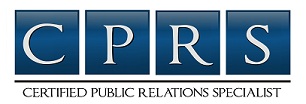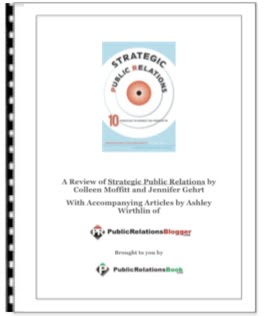________________________________________________________________________
 For those business, non-profit and association managers committed to PR tactics like radio and newspaper plugs, it can come as a surprise to discover where public relations value REALLY lies.
For those business, non-profit and association managers committed to PR tactics like radio and newspaper plugs, it can come as a surprise to discover where public relations value REALLY lies.
Truth is, your PR budget can deliver results far beyond such limited publicity placements.
For example by embracing the kind of PR plan that persuades those important outside audiences to your way of thinking, and moving them to take actions that help your department, division or subsidiary succeed.
Then by using the high-impact, fundamental premise of public relations to deliver external stakeholder behavior change the kind that leads directly to achieving your managerial objectives.
And finally by revving up the creative potential of your assigned PR team or agency and involving them in a way that positively impacts the behaviors of the very outside audiences that MOST affect your unit.
Perhaps then you will find yourself with a basketful of results such as prospects starting to do business with you; community leaders beginning to seek you out; newly arrived proposals for strategic alliances and joint ventures; customers starting to make repeat purchases; membership applications on the rise; politicians and legislators beginning to think of you as a key member of the business, non-profit or association communities; welcome bounces in show room visits; and even capital givers or specifying sources starting to look your way.
Spend a moment here and read that fundamental public relations blueprint referred to above: People act on their own perception of the facts before them, which leads to predictable behaviors about which something can be done. When we create, change or reinforce that opinion by reaching, persuading and moving-to-desired-action the very people whose behaviors affect the organization the most, the public relations mission is accomplished.
This lets you broaden your public relations field of fire, putting its primary focus where it belongs, on your units key external stakeholder behaviors.
A caveat here: be sure that the public relations personnel assigned to your unit really believe deep down -- why its SO important to know how your most important outside audiences perceive your operations, products or services. Be certain they accept the reality that perceptions almost always lead to behaviors that can help or hurt your unit.
Review with them your blueprint for monitoring and gathering perceptions by questioning members of your most important outside audiences. Questions like these: How much do you know about our services or products and employees? How much do you know about our chief executive? Have you had prior contact with us and were you pleased with the interchange? Have you experienced problems with our people or procedures?
When you think of it, youre fortunate that your PR folks already are in the perception and behavior business so they can jump right on the perception monitoring assignment. If your budget can handle it, you can always use a professional survey firm, but they can be very expensive. Nevertheless, whether its your people or a survey firm asking the questions, your objective is to identify untruths if not outright lies, false assumptions, unfounded rumors, inaccuracies, and misconceptions .
Now you must carefully select which of the above aberrations qualifies as your corrective public relations goal for example, clarify the misconception, spike that rumor, correct the false assumption or fix certain other inaccuracies.
Now, if you pick the wrong strategy to show you how to reach your goal, it will feel like youre eating Roast Turkey without the stuffing. Fact is, you can only achieve your PR goal by picking the right strategy from the three choices available to you, change existing perception, create perception where there may be none, or reinforce it. And take care that your new strategy is a natural fit with that new public relations goal.
Sooner or later you will have to address your key stakeholder audience in a way that will help persuade them to your way of thinking. So assign the task to your very best writer because s/he must put together some very special, corrective language. Words, by the way, that are not only compelling, persuasive and believable, but clear and factual if they are to shift perception/opinion towards your point of view and lead to the behaviors you have targeted.
Here you take an easy step select the communications tactics needed to carry your message to the attention of your target audience. Checking, of course, that the tactics you select are known to reach folks like your audience members. Dozens are available from speeches, facility tours, emails and brochures to consumer briefings, media interviews, newsletters, personal meetings and many others.
Because HOW one communicates often affects the believability of the message, you may wish to deliver it in smaller meetings or presentations rather than high-profile media such as a news release..
Questions will arise as to indications of progress. That will be your signal to schedule a second perception monitoring session with members of your external audience. You will use many of the same questions as in the first benchmark session. But you will now be watching carefully for signs that the offending perception is actually moving in your direction.
A fortunate reality in the public relations business is that these matters usually can be accelerated by adding more communications tactics as well as increasing their frequencies.
Yes, as a manager, it may surprise you that a workable public relations blueprint like this one will help you persuade your most important outside stakeholders to your way of thinking, then move them to behave in a way that leads to the success of your department, division or subsidiary.
But its no surprise that the people you deal with behave like everyone else they act upon their perceptions of the facts they hear about you and your operation. Leaving you little choice but to deal promptly and effectively with those perceptions by doing what is necessary to reach and move those key external audiences to action.
Please feel free to publish this article and resource box in your ezine, newsletter, offline publication or website. Robert A. Kelly 2004.
About The Author
Bob Kelly counsels, writes and speaks to business, non-profit and association managers about using the fundamental premise of public relations to achieve their operating objectives. He has been DPR, Pepsi-Cola Co.; AGM-PR, Texaco Inc.; VP-PR, Olin Corp.; VP-PR, Newport News Shipbuilding & Drydock Co.; director of communi- cations, U.S. Department of the Interior, and deputy assistant press secretary, The White House. He holds a bachelor of science degree from Columbia University, major in public relations. [email protected]. Visit his website.
Article Source.
Tags: public relations, public relations planning, PR plan
Public Relations Planning
________________________________________
 For those business, non-profit and association managers committed to PR tactics like radio and newspaper plugs, it can come as a surprise to discover where public relations value REALLY lies.
For those business, non-profit and association managers committed to PR tactics like radio and newspaper plugs, it can come as a surprise to discover where public relations value REALLY lies.Truth is, your PR budget can deliver results far beyond such limited publicity placements.
For example by embracing the kind of PR plan that persuades those important outside audiences to your way of thinking, and moving them to take actions that help your department, division or subsidiary succeed.
Then by using the high-impact, fundamental premise of public relations to deliver external stakeholder behavior change the kind that leads directly to achieving your managerial objectives.
And finally by revving up the creative potential of your assigned PR team or agency and involving them in a way that positively impacts the behaviors of the very outside audiences that MOST affect your unit.
Perhaps then you will find yourself with a basketful of results such as prospects starting to do business with you; community leaders beginning to seek you out; newly arrived proposals for strategic alliances and joint ventures; customers starting to make repeat purchases; membership applications on the rise; politicians and legislators beginning to think of you as a key member of the business, non-profit or association communities; welcome bounces in show room visits; and even capital givers or specifying sources starting to look your way.
Spend a moment here and read that fundamental public relations blueprint referred to above: People act on their own perception of the facts before them, which leads to predictable behaviors about which something can be done. When we create, change or reinforce that opinion by reaching, persuading and moving-to-desired-action the very people whose behaviors affect the organization the most, the public relations mission is accomplished.
This lets you broaden your public relations field of fire, putting its primary focus where it belongs, on your units key external stakeholder behaviors.
A caveat here: be sure that the public relations personnel assigned to your unit really believe deep down -- why its SO important to know how your most important outside audiences perceive your operations, products or services. Be certain they accept the reality that perceptions almost always lead to behaviors that can help or hurt your unit.
Review with them your blueprint for monitoring and gathering perceptions by questioning members of your most important outside audiences. Questions like these: How much do you know about our services or products and employees? How much do you know about our chief executive? Have you had prior contact with us and were you pleased with the interchange? Have you experienced problems with our people or procedures?
When you think of it, youre fortunate that your PR folks already are in the perception and behavior business so they can jump right on the perception monitoring assignment. If your budget can handle it, you can always use a professional survey firm, but they can be very expensive. Nevertheless, whether its your people or a survey firm asking the questions, your objective is to identify untruths if not outright lies, false assumptions, unfounded rumors, inaccuracies, and misconceptions .
Now you must carefully select which of the above aberrations qualifies as your corrective public relations goal for example, clarify the misconception, spike that rumor, correct the false assumption or fix certain other inaccuracies.
Now, if you pick the wrong strategy to show you how to reach your goal, it will feel like youre eating Roast Turkey without the stuffing. Fact is, you can only achieve your PR goal by picking the right strategy from the three choices available to you, change existing perception, create perception where there may be none, or reinforce it. And take care that your new strategy is a natural fit with that new public relations goal.
Sooner or later you will have to address your key stakeholder audience in a way that will help persuade them to your way of thinking. So assign the task to your very best writer because s/he must put together some very special, corrective language. Words, by the way, that are not only compelling, persuasive and believable, but clear and factual if they are to shift perception/opinion towards your point of view and lead to the behaviors you have targeted.
Here you take an easy step select the communications tactics needed to carry your message to the attention of your target audience. Checking, of course, that the tactics you select are known to reach folks like your audience members. Dozens are available from speeches, facility tours, emails and brochures to consumer briefings, media interviews, newsletters, personal meetings and many others.
Because HOW one communicates often affects the believability of the message, you may wish to deliver it in smaller meetings or presentations rather than high-profile media such as a news release..
Questions will arise as to indications of progress. That will be your signal to schedule a second perception monitoring session with members of your external audience. You will use many of the same questions as in the first benchmark session. But you will now be watching carefully for signs that the offending perception is actually moving in your direction.
A fortunate reality in the public relations business is that these matters usually can be accelerated by adding more communications tactics as well as increasing their frequencies.
Yes, as a manager, it may surprise you that a workable public relations blueprint like this one will help you persuade your most important outside stakeholders to your way of thinking, then move them to behave in a way that leads to the success of your department, division or subsidiary.
But its no surprise that the people you deal with behave like everyone else they act upon their perceptions of the facts they hear about you and your operation. Leaving you little choice but to deal promptly and effectively with those perceptions by doing what is necessary to reach and move those key external audiences to action.
Please feel free to publish this article and resource box in your ezine, newsletter, offline publication or website. Robert A. Kelly 2004.
About The Author
Bob Kelly counsels, writes and speaks to business, non-profit and association managers about using the fundamental premise of public relations to achieve their operating objectives. He has been DPR, Pepsi-Cola Co.; AGM-PR, Texaco Inc.; VP-PR, Olin Corp.; VP-PR, Newport News Shipbuilding & Drydock Co.; director of communi- cations, U.S. Department of the Interior, and deputy assistant press secretary, The White House. He holds a bachelor of science degree from Columbia University, major in public relations. [email protected]. Visit his website.
Article Source.
Tags: public relations, public relations planning, PR plan
Popular choices
- Non Gamstop Casino
- Mejores Salas De Póker
- Non Gamstop Casinos
- Siti Casino Online Non Aams
- Migliori Siti Casino Online
- UK Online Casinos Not On Gamstop
- Non Gamstop Casino Sites UK
- Non Gamstop Casino Sites UK
- UK Casino Not On Gamstop
- Casinos Not On Gamstop
- Online Casino
- オンラインカジノ
- UK Casino Not On Gamstop
- UK Casino Not On Gamstop
- Reputable Non Gamstop Casinos
- Casinos Not On Gamstop
- Best Non Gamstop Casinos
- Non Gamstop Casino
- Casinos Not On Gamstop
- Slots Not On Gamstop
- Non Gamstop Casino
- Casino Non Aams
- Casinos Not On Gamstop
Subscribe to:
Post Comments (Atom)






Comments (0)
Post a Comment